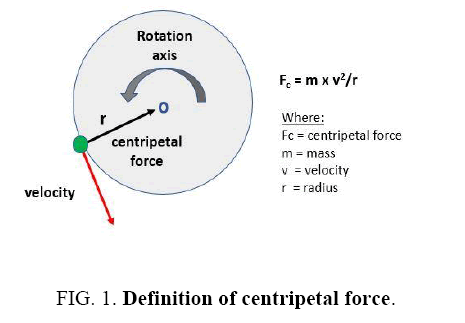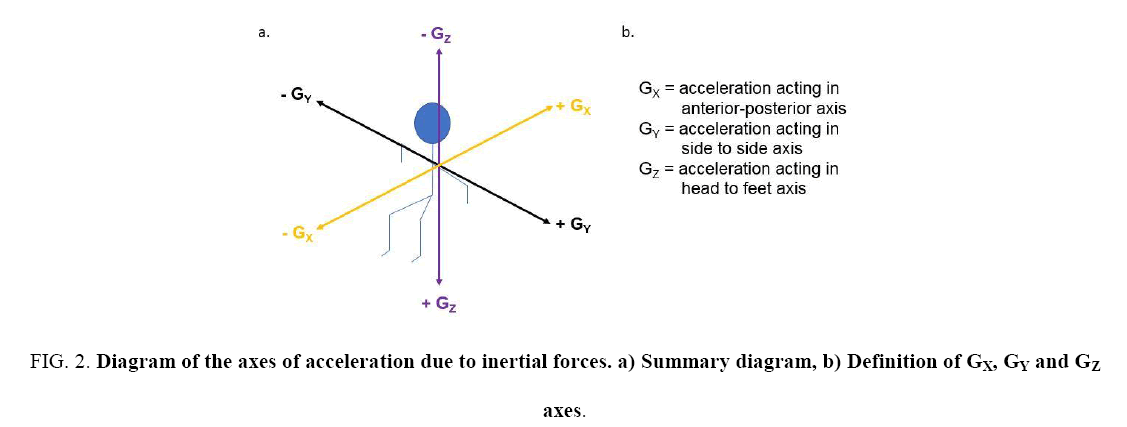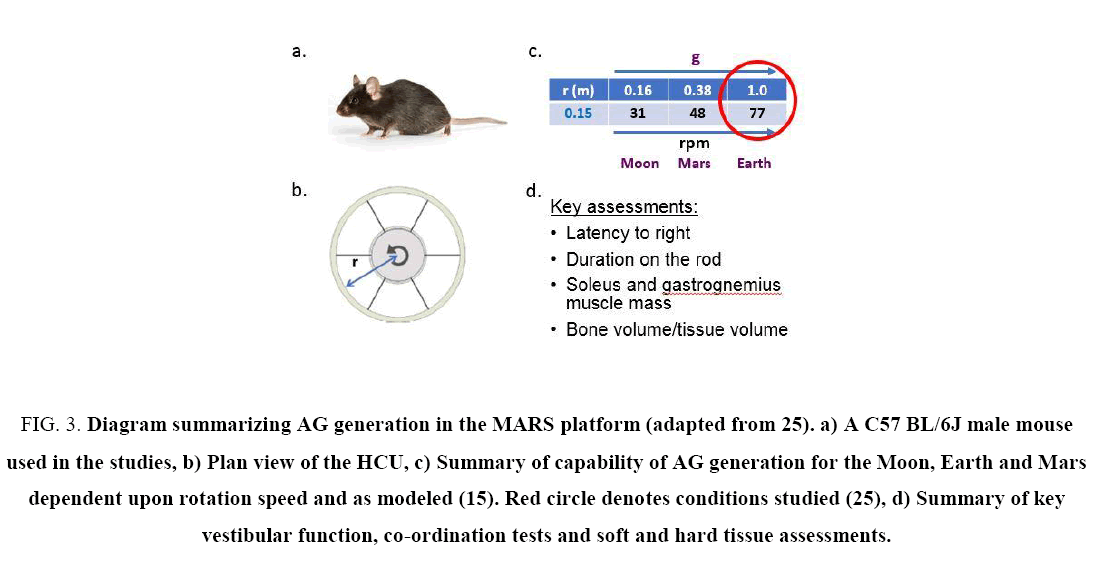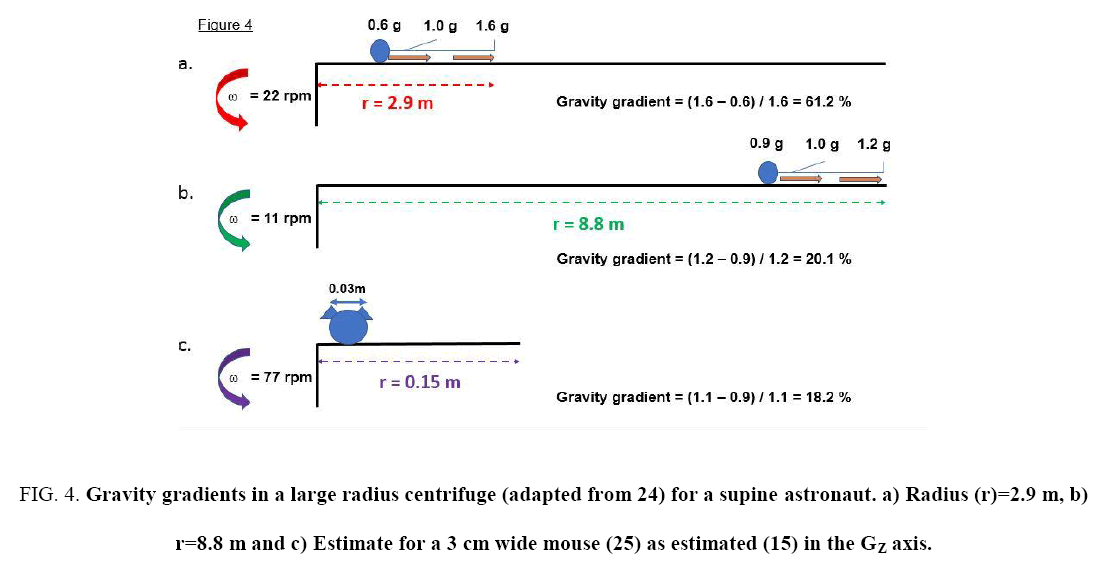Review
, Volume: 6( 3)Artificial Gravity: Small Steps on the Journey to the Giant Leap
- *Correspondence:
- Martin Braddock, Sherwood Observatory, Mansfield and Sutton Astronomical Society, Coxmoor Road, Sutton-in-Ashfield, Nottinghamshire, United Kingdom, Tel: +44 (0) 7748 761258; E-mail: projects@sherwoodobservatory.org.uk
Received: November 30, 2017; Accepted: December 14, 2017; Published: December 20, 2017
Citation: Braddock M. Artificial Gravity: Small Steps on the Journey to the Giant Leap. J Space Explor. 2017;6(3):137
Abstract
The adverse effects of prolonged exposure to microgravity can be predicted by observations in astronauts and animals on short duration space flight. Long term space travel to Mars and beyond will demand countermeasures to microgravity habitation and theoretically the most promising is living in an environment in the presence of simulated or artificial gravity. An international roadmap for artificial gravity research clearly sets a bold ambition for the next 8 years plus and one small step, namely proof that artificial gravity generated in space can attenuate soft and hard tissue atrophy in mice has just been taken.
Keywords
Gravity; Space; Environment
Introduction
It is now well accepted that a serious limitation of the ergonomics supporting space travel is the environment of microgravity. Both physiological and psychological affects experienced by astronauts have been extensively reviewed together with an exhaustive set of actual and potential countermeasures, which include both exercise regimes and pharmaceutical intervention [1-10]. Animal, particularly vertebrate adaptation to 1 g has been present on Earth since life started to colonize land from the sea approximately 385 million years ago in the late Devonian period, in part due to the development of lungs from gills and an enhanced capacity for vision [11]. Thus, all terrestrial life not supported by the buoyancy of water has evolved in the presence of this constant force called gravity. More than a century ago, Konstantin Tsiolkovsky, who laid the foundation for modern rocketry proposed and described artificial gravity. In 1903, Tsiolkovsky published ‘The Exploration of Space by Means of Jet Devices’ where he developed the mathematical foundation of modern spacecraft astronautics [12]. Importantly, his paper included the concept of a rotating environment, capable of generating artificial gravity (AG) [13]. In 1920, Tsiolkovsky published the forward looking ‘Beyond Planet Earth’ paper where, over 40 years before anybody had flown in space, he anticipated many of the problems associated with living and working in a weightless environment, including tissue atrophy and the need for resistance training [14]. Of particular importance here, he described how AG could be produced by habitat rotation, taking into account the rotation radius, rotation speed and the ability of human beings to move within the habitat [14].
Experimental
Although the term AG is widely accepted in the scientific literature, it is in part a misnomer and the term simulated gravity may be more accurate. Nevertheless, the term AG will be used throughout this review and it rather than being a form of ‘gravity’, is more correctly the centripetal acceleration force and concomitant inertial forces that result from continuous exposure to radial motion experienced by humans in a centrifuge, or rotating habitat. It can be easily predicted and tested [15] as shown in Figure 1. and this centripetal acceleration force is the closest approximation to real gravity that we can produce today [16-19].
Human beings are, in keeping with Einstein’s Theory of Equivalence, unable to distinguish between the effects of acceleration generated by gravitation or centrifugation, however the Coriolis force which is produced by head motion during centrifugation, that is within the frame of reference, may lead to tumbling sensations which can induce nausea and be both unpleasant and distracting [20,21]. This sensation in the vestibular canals, termed Coriolis cross-coupling has been under great scrutiny in G-flight training exercises for pilots and astronauts [22,23] and is dependent upon the rotation speed of the habitat, rotation radius and the subsequent gravity gradient, especially along the GZ axis, although gradients along both GX and GY axes have to be considered and the axes are illustrated in Figure 2.
Figure 2: Diagram of the axes of acceleration due to inertial forces. a) Summary diagram, b) Definition of GX , GY and GZ axes.
Now and at the time of writing this article in November 2017, we have just witnessed the publication of the International Roadmap for Artificial Gravity Research [24]. The roadmap sets out a vision for AG research drawn from space agencies in US, Europe and Japan together with scientists from around the world who are dedicating their studies to AG research. One such study was reported in September 2017 and is the first step, which shows that AG when generated in space can attenuate the effects of microgravity on soft and hard tissue atrophy [25].
Results
The recent study published by the team at JAXA [25] utilises an innovative platform called MARS – Multiple artificial-gravity research system. In this platform, mice were subjected to AG generated in situ on the International Space Station (ISS). A specially designed centrifuge equipped biological experimental facility (CBEF) comprised habitat cage units (HCU) of 0.15 m radius housing 6 animals each and were exposed to either microgravity (MG) or AG. The HCU delivering AG to the animals was rotated at 77 rpm which generated Earth’s gravity of 1 g. Rotation speeds may be varied to simulate gravity experience on the Moon or Mars, which will be investigated in future missions. Animals were housed for 34.6 days in the HCU under MG conditions and for 34.1 days under AG of 1 g during the 37 days berthing period. The experimental system and the key experimental assessments made are summarised in Figure 3.
Figure 3: Diagram summarizing AG generation in the MARS platform (adapted from 25). a) A C57 BL/6J male mouse used in the studies, b) Plan view of the HCU, c) Summary of capability of AG generation for the Moon, Earth and Mars dependent upon rotation speed and as modeled (15). Red circle denotes conditions studied (25), d) Summary of key vestibular function, co-ordination tests and soft and hard tissue assessments.
Although the lack of available instrumentation on the ISS prevented the measurement of body weight, food and water consumption, the animal cohorts were examined on return to Earth, their body weight measured and were found to be in generally good condition.
Animals were subsequently examined by several tests and then sacrificed and various physical parameters measured to determine the effects of AG and MG when compared with animals of the same on Earth which acted a ground controls (GC). Vestibular function and co-ordination movement were determined by a mid-air righting reflex and rotarod tests respectively. Latency to righting was increased in the mice exposed to MG when compared with their AG and GC counterparts and although the differences were not significantly different, the trends are consistent with the notion that the sense of self-orientation in space is impaired in mice exposed to MG. In the rotarod test, which is a test of how long animals stay on a rotating rod, both groups of animals subjected to AG and MG showed decreased duration when compared with the GC counterpart suggesting impaired motor coordination in these groups.
Subsequently, the animals were sacrificed and the body-weight normalised skeletal muscle mass was determined together with the bone volume/tissue volume percentage using micro computed topography scanning and three dimensional structural imaging of the right femurs of animals in each of the AG, MG and GC groups. Remarkably, there was a decrease of approximately 90% difference in both soleus and gastrocnemius muscle mass normalised to body weight. Moreover, AG almost completely suppressed bone loss induced by MG, with the percentage bone volume/tissue volume in animals subjected to AG nearly identical to their GC counterparts. This study is of particularly significance as it represents the first study which shows that the generation of AG in situ, that is in space on board the ISS can prevent space-induced soft and hard tissue atrophy. This study paves the way for further studies in the MARS platform where different g forces can be applied and different g regimens which may involve exposure to both continuous and discontinuous episodes of AG.
Questions for future research
In developing AG for astronaut habitation in space or ultimately where surface gravity<1 g, one key question is what g force is essential for normal growth and development experienced on Earth? It is known that in animal studies on Earth where mice were exposed to partial weight-bearing suspension for 21 days, simulated Martian gravity of 0.38 g was not sufficient to protect against bone loss but did attenuate the reduction in soleus muscle mass [26-28]. A 36 patient study in the long term bedridden showed attenuated bone metabolism and a reduction in bone mineral density below the cut-off ascribed to patients with osteoporosis [29]. These two studies, albeit abstracted from the situation faced by healthy astronauts in microgravity tend to suggest that higher g forces will be required to maintain healthy bone mass. To that end, future missions may see the JAXA ISS MARS platform be used to provide AG to murine studies in situ and by virtue of the variability in rotation rate of the centrifuge, generate gravitational forces between 0.38 found on Mars and 1 g found on Earth. Such studies may help determine what exercise and intervention regimens astronauts require on Mars and whether future habitats supplied with intermediate g forces may provide sufficient countermeasures to tissue atrophy.
The roadmap identifies 5 clear gaps in our knowledge and describes the tasks to be carried out to fill these gaps [24]. Gap 1 (2017-2024) will attempt to address the issue of g dose response in vitro and in vivo model systems on Earth and on the ISS, together with studies in human subjects in terrestrial analogs of weightlessness such as head out water immersion and head down tilt bead rest and locomotion studies where subjects are suspended by cables thus receiving a mimic of <1g. Gap 2 (2018-2021) has already been described above and will extend our understanding of the effect of Martian gravity on tissue atrophy in mice on the ISS, together with testing of Martian gravity conditions in terrestrial analogs on human subjects. Gap 3 (2017-2022) will test the different regimens of AG production in intermittent or continuous rotation in humans on Earth and in rats on board the ISS. Gap 4 (2017-2020) comprises studies which are all Earth bound and will test a number of parameters in human subjects as part of the determination of conditions which are acceptable to astronaut health. These include assessment of health effects from rotation studies in both short and long-term centrifuges and exercising within the short rotation centrifuge and the generation of the Coriolis and cross-coupled accelerations during head or body movements. The ultimate step on our giant leap can be made when we can answer the question when might we be able to explore the effects of AG in situ on astronauts and how will we achieve a device capable of delivering AG under conditions and over a period where the risk benefit is acceptable to the subjects? The answer will be a culmination of studies addressing gap 5 (2019-2024 and beyond) where astronauts are anticipated to be exposed to AG in short radius centrifuge space based operations studies in 2024 and in orbital studies in>2024.
Discussion
Many designs of space stations have been proposed which could, in theory be capable of generating AG [30-32]. It is beyond the scope of this review to summarize the vast literature which has been published over the years although a brief account is warranted here. The concept of a ring-shaped rotating space station was previously proposed by Herman Poto?nik in 1929 and developed further by Wernher von Braun. The Stanford torus was a design proposed by NASA in 1975 for a space habitat capable of housing 10, 000 to 140, 000 permanent residents [33]. Addressing many of the issues associated with provision of a habitat conducive to living and working in 1g, it soon became apparent that it was both technically unfeasible to develop at the time and too costly to implement a construction plan. Predicting a mass of 10 million tons (including a radiation shield of 1.7 m lunar soil, habitat and atmosphere), it was to have 6 spokes, rotate at 1 rpm and generated between 0.9 g-1.0 g. To be able to achieve this, the diameter of the space station was estimated at 1, 790 m to provide a habitation tube diameter of 130 m. Even if construction of a space station of this magnitude is possible today, the design considerations go far beyond the size and the provision of energy to provide life-support systems and space rotation is beyond our current technology, most likely at a cost effectiveness nations of the Earth would not be willing to indulge.
Other designs may obviate the need for huge rotating space stations by having a smaller habitation rotate on a tether which may permit a large rotation radius but without the need for a large habitation structure [30]. More recent and more realistic designs in collaboration with NASA consider the construction of growth-adapted tensegrity structures (GATS) which may permit modular growth of space stations to provide rotating habitats [34]. The Bigelow expandable activity module (BEAM), is an alternative design and an expandable habitat technology for the ISS [35]. As BEAM expands after being deployed in space, it requires minimal payload volume on a rocket, offering low mass modules which could increase the efficiency of cargo shipments. It may provide some protection from solar and cosmic and UV radiation and space debris and be adapted in future to provide a rotating habitat.
The International Roadmap for AG research is asking for key questions to be answered which, will ultimately support the study of the effects of AG on humans in space operations and in Earth orbit in 2024 and beyond. Clearly, today the availability of centrifuges for carrying out studies in space are limited and further development is essential for this to be reality. When considering the size of the centrifuge, astronautical engineers must consider radius not only in terms of distance from the radial centre with respect to rotation speed to generate the required AG, but what gravity gradient will be established and permissible for astronaut health. In Figure 4, adapted from [24], the gravity gradient is illustrated for an astronaut in the supine position in a large radius centrifuge at a short (2.9 m), and large radius (8.8 m) from the radial centre with rotation speeds of 22 rpm and 11 rpm respectively. From the design configuration of the HCU [25], taking the width of a mouse (strain C57 BL/6J used in the study) to be 3 cm, and deriving the gravity the animals experience (15), the gravity gradient the animals may experience along the GZ axis is estimated to be 18%. Such studies on humans will establish the effect of AG on ocular structure and anatomy, intracranial pressure and fluid accumulation and be informative for the design configuration and size of the space sited centrifuge.
Figure 4: Gravity gradients in a large radius centrifuge (adapted from 24) for a supine astronaut. a) Radius (r)=2.9 m, b) r=8.8 m and c) Estimate for a 3 cm wide mouse (25) as estimated (15) in the GZ axis.
Human beings have learnt to manage and to adapt to a number of physiological stresses. These include living in conditions of temperature extremes [36-38], high altitude exposure to hypoxia [39,40] and in environments more susceptible to pathogenic infection [41]. In some instances, such conditions drive genetic changes over generations resulting in phenotypic adaptation [42]. Perhaps such changes will be the result of multi-generational habitation in microgravity, ultimately leading to a change in body plan and morphology aligned to the new g force normale, whether it be on Mars or another planet [43].
Conclusion
Clearly, there are many immediate challenges ahead with astronaut safety of paramount importance. The international roadmap is a truly cross functional multi space agency effort which utilizes all the scientific ingenuity of mankind. The development of the road map and in particular, the proof of concept that AG generated in space can attenuate tissue atrophy, albeit in mice, has enabled us to take one small step on the journey to the giant leap.
References
- Kast J, Yu Y, Seubert CN, et al. Drugs in space: Pharmacokinetics and pharmacodynamics in astronauts. Eur J Pharm Sci. 2017;109S:S2-S8.
- Braddock M. Ergonomic challenges for astronauts during space travel and the need for space medicine. J. Ergonomics. 2017;7(6):1-10.
- Lang T, van Loon JJWA, Bloomfield S, et al. Towards human exploration of space: the THESEUS review series on muscle and bone research priorities. NPJ Microgravity. 2017;3:8.
- Flynn-Evans EE, Barger LK, Kubey AA, et al. Circadian misalignment affects sleep and medication use before and during spaceflight. NPJ Microgravity. 2015;2:15019.
- Barger LK, Flynn-Evans EE, Kubey A, et al. Prevalence of sleep deficiency and hypnotic use among astronauts before, during and after spaceflight: An observational study. Lancet Neurol. 2014;13:904-12.
- Sylos-Labini F, Lacquaniti F, Ivanenko YP. Human locomotion under reduced gravity conditions: Biomechanical and neurophysiological considerations. BioMed Res Int. 2014:1-12.
- Cassady K, Koppelmans V, Reuter-Lorenz P, et al. Effects of spaceflight analog environment on brain connectivity and behaviour.Neuroimage. 2016;141:18-30.
- Kokhan VS, Matveeva MI, Mukhametova A, et al. Risk of defeats in the central nervous system during deep space missions. NeurosciBiobehav Rev. 2016;71:621-32.
- Aubert AE, Larina I, Momken I, et al. Towards human exploration of space: The THESEUS review series on cardiovascular, respiratory and renal research properties. NPJ Microgravity. 2016;2:16031.
- Van Ombergen A, Demertzi A, Tomilovskaya E, et al. The effects of spaceflight and microgravity on the human brain. J Neurol. 2017;264:18-22.
- MacIver MA, Schmitz L, Mugan U, et al. Massive increase in visual range preceded the origin of terrestrial vertebrates. ProcNatlAcadSci USA. 2017;114:E2375-84.
- Tsiolkovsky, Konstantin E. The Exploration of Cosmic Space by Means of Reaction Devices. Sci Rev. 1903.
- Logsdon JM, Butler G. Space Station and Space Platform Concepts: A Historical Review. In: Bekey I, Herman D, editors. 1985 Space Stations and Space Platforms – Concepts, Design, Infrastructure, and Uses (p. 203-263). Reston, Virginia, USA: American Institute of Aeronautics and Astronautics.
- Tsiolkovsky KE. Beyond the Planet Earth. Trans Kenneth Syers. Pergamon Press, UK;1920.
- https://www.artificial-gravity.com/sw/SpinCalc
- Clement G. Artificial gravity evidence report. NASA Human Research Program. 2015.
- Clement GR, Bukley AP, Paloski WH. Artificial gravity as a countermeasure for mitigating physiological deconditioning during long-duration space missions. Front Sys Neurosci. 2015;9: 92.
- Clement GR, Charles JB, Paloski WH. Revisiting the needs for artificial gravity during deep space missions REACH. Reviews in Human Space Exploration. 2016;1:1-10.
- Clement GR, Bukley AP, Paloski WH. Artificial gravity as a countermeasure for mitigating physiological deconditioing during long-duration space missions.Front SystNeurosci. 2015;9:92.
- Guedry FE, Benson AJ. Coriolis cross-coupling effects: Disorientating and nauseogenic or not? Naval Aerosp Med Res Lab. 1977:1-20.
- Lackner JR, DiZio P. Space motion sickness. Exp Brain Res. 2006;175: 377-99.
- Bonjour J, Bringard A, Antonutto G, et al. Effects of acceleration in the Gz axis on human cardiopulmonary responses to exercise. Eur J Appl Physiol. 2011;111:2907-17.
- Albery WB. Acceleration in other axes affects+Gz tolerance: Dynamic centrifuge simulation of agile flight. Aviat Space Environ Med. 2004;75:1-6.
- Clement G. International roadmap for artificial gravity research. NPJ Microgravity 3:29.
- Shiba D, Mizuno H, Yumoto A, et al. Development of new experimental platform ‘MARS’ – Multiple artificial-gravity research system – to elucidate the impacts of micro/partial gravity on mice. Sci Rep. 2017;7:10837.
- Morita H, Obata K, Abe C, et al. Feasibility of a short-arm centrifuge for mouse hypergravity experiments. PLoS One. 2015;10:e0133981.
- Ellman R, Spatz J, Cloutier A, et al. Partial reductions in mechanical loading yield proportional changes in bone density, bone architecture, and muscle mass. J Bone Miner Res. 2013;28:875-85.
- Ackermann M, van den Bogert AJ. Predicitve simulation of gait at low gravity reveals skipping as the preferred locomotion strategy.J Biomech. 2012;45:1293-98.
- Eimori K, Endo N, Uchiyama S, et al. Disrupted bone metabolism in long-term bedridden patients. PLoS One. 2016;11:e0156991.
- www.artificial-gravity.com/ISU-2010-Rousek.pdf
- Hall TW. Artificial gravity and the architecture of orbital habitats.J Brit Interplanetary Soc. 1999;52: 290-300.
- Hall TW. Artificial gravity in theory and in practice. 46th International Conference on Environmental Systems ICES-2016-194 Vienna, Austria; 2016
- Potocnik H. In: Das Problem der Befahrung des Weiltraums – der Raketen – Motor. Schmidt publishers, Germany; 1929.
- settlement.arc.nasa.gov/75SummerStudy/Table_of_Contents1.html
- www.nasa.gov/content/growth-adapted-tensegrity-structures-a-new-calculus-for-the-space-economy.
- www.nasa.gov/image-feature/the-bigelow-expandable-aerospace-module-beam.
- Fumagalli M, Moltke I, Garup N, et al. Greenlandic Inuit show signatures of diet and climate adaptation. Science. 2015;349:1343-7.
- Daanen Ham, van MarkenLichtenbelt VM. Human whole body cold adaptation. Temperature 2016;3:104-18.
- Gibson OR, Taylor L, Watt PW, et al. Cross-adaptation: Heat and cold adaptation to improve physiological and cellular responses to hypoxia. Sports Med. 2017;47:1751-68.
- Bigham AW, Lee FS. Human high-altitude adaptation: Forward genetics meets the HIF pathway. Genes Dev. 2014;28:2189-204.
- Peng Y, Cui C, He Y, et al. Down-regulation of EPAS1 transcription and genetic adaptation of Tibetans to high altitude hypoxia. MolBiolEvol. 2017;34:818-30.
- Daub JT, Hofer T, Cutivet E, et al. Evidence for polygenic adaptation to pathogens in the human genome. MolBiolEvol. 2013;30:1544-58.
- Petousi N, Croft QP, Cavalleri GL, et al. Tibetans living at sea level have a hyporesponsive hypoxia-inducible factor system and blunted physiological responses to hypoxia. J Appl Physiol. 1985;116:893-904.





